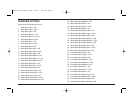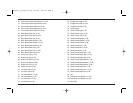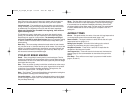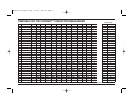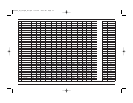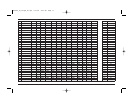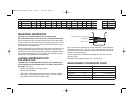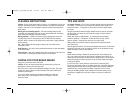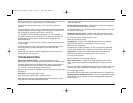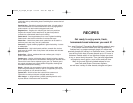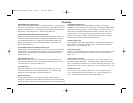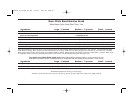
CLEANING INSTRUCTIONS
Caution: Do not put the bread maker in water or in a dishwasher. Do not use
benzene, scrubbing brushes or chemical cleaners, as these will damage the
machine. Use only a mild, nonabrasive cleanser to clean the outside of the
bread maker.
Baking pan and kneading paddle – Pan and kneading blade are fully
immersible and dishwasher safe. Do not use metal utensils with the baking
pans as they will damage the nonstick surface.
Baking chamber – Remove all bread crumbs by wiping them away with
a slightly damp cloth or clean pastry brush. DO NOT bend the heating
element, which is located on the inside of the bread maker. Unplug machine
before cleaning.
Lid – Wipe inside of lid with sponge or damp cloth. Lid should not be
immersed in water.
Outer Housing – Use only a mild, nonabrasive cleanser to clean the outside
of the bread maker.
Control Panel – Wipe with a slightly damp cloth as necessary. Take care not
to allow water or cleaning fluids under buttons of control panel.
CARING FOR YOUR BREAD MAKER
Keep your bread maker clean at all times.
Caution: Do not use metal utensils with the bread maker, as they will
damage the non-stick pan and other parts.
Don’t worry if the colour of the baking pan changes over time. The colour
change is a result of steam and other moisture and does not affect the
machine’s performance.
If you have trouble removing the kneading paddle from bread pan,
place warm water in the bread pan for 10 to 15 minutes – this will
loosen the blade.
TIPS AND HINTS
For higher altitudes – Flour is drier at higher altitude levels and will absorb
more liquid – use less flour in the recipe. Pay attention to the dough as it
mixes and kneads – if it appears dry, add more of the same liquid used in
the recipe.
Doughs prepared and baked at higher altitude levels will tend to rise faster –
use less yeast, a bit more salt, and a little less sugar to help counteract
this phenomenon.
Bread rises higher in high altitudes – try reducing the recommended
amount of yeast by
1
⁄4–
1
⁄2 teaspoon. If bread still rises too high, reduce
yeast by another
1
⁄4 teaspoon the next time you try the recipe.
Adding a little more salt will retard the yeast action and promote slower,
more even rising.
Add vital gluten or lecithin. This will help to stabilize the structure of the bread
and make it less likely to fall or collapse. Lecithin can be purchased in most
health food stores or natural food markets.
Usage
Bread machine baking is affected by the temperature and humidity of the
day – this is often the cause of varied dough consistency and results. On a
humid day, the best method of measuring is to weigh the flour. A cup of white
bread flour weighs 5 ounces/140 grams. A cup of whole wheat flour weighs
4 ounces/120 grams.
If you do not have a scale (electronic works best for measuring flour),
let your eye and hands guide you in adding more flour or liquid as necessary.
Dough should be smooth and not cling to fingers when touched. Additional
amounts of flour or liquid should be added 1 teaspoon (5 ml) at a time.
Giving the kneading paddle a light coating with a nonstick cooking spray,
shortening or vegetable oil may make it easier to remove if it bakes into
a loaf.
14
cbk200c_ib_recipe_en.qxd 5/19/05 9:05 AM Page 15



